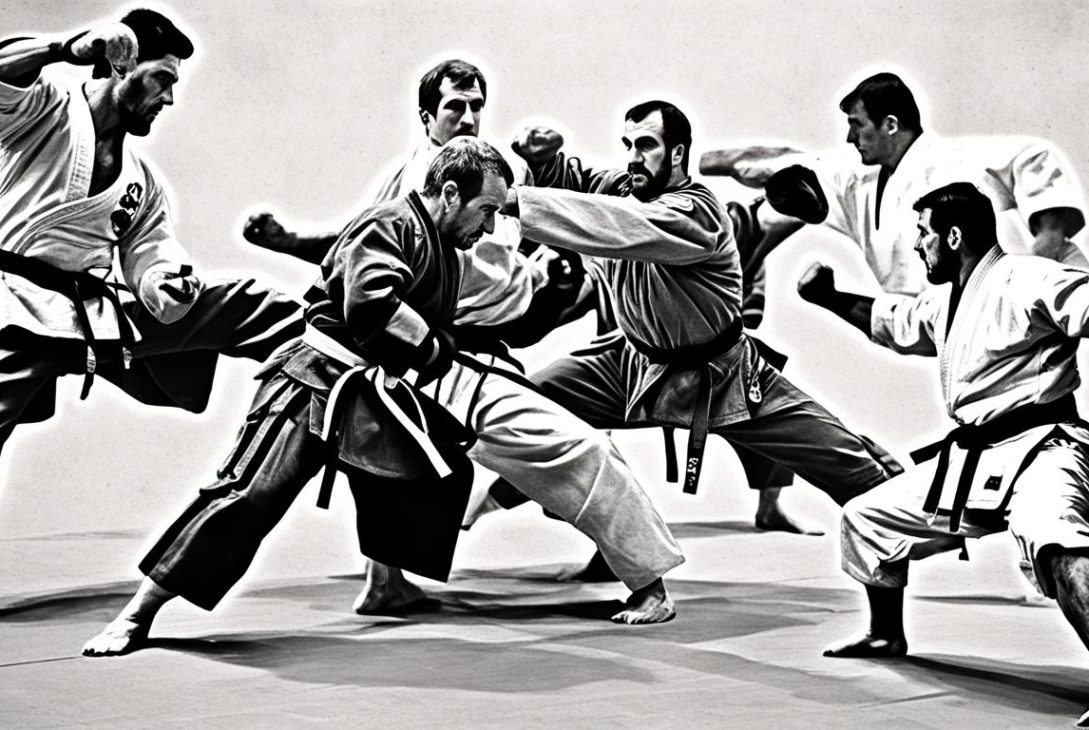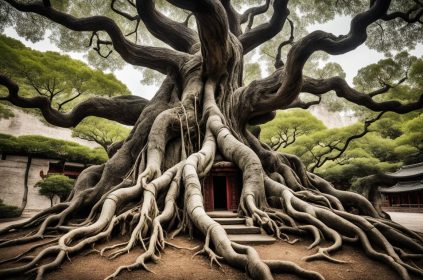Sambo, a martial art developed in the Soviet Union, has a rich history and global impact on combat sports. It combines techniques from Judo, Jiu-Jitsu, and other styles of wrestling. Sambo was created to enhance the hand-to-hand combat skills of Soviet Military Personnel. It is known for its takedowns, ground control skills, and leg locks. Vasili Oshchepov and Viktor Spiridonov are considered the founding fathers of Sambo, combining various martial arts techniques to create the new system. Sambo officially became the country’s combat sport in 1938 and was used to unite the various ethnic groups within the USSR. It has gained popularity worldwide, with notable practitioners like Fedor Emelianenko and Khabib Nurmagomedov.
Key Takeaways:
- Sambo is a martial art developed in the Soviet Union that combines techniques from Judo, Jiu-Jitsu, and wrestling.
- It was created to enhance the hand-to-hand combat skills of Soviet Military Personnel.
- Vasili Oshchepov and Viktor Spiridonov are the founding fathers of Sambo.
- Sambo officially became the country’s combat sport in 1938.
- It has gained popularity worldwide and is practiced by notable practitioners like Fedor Emelianenko and Khabib Nurmagomedov.
Early Development of Sambo
In the early 20th century, Vasili Oshchepov and Viktor Spiridonov, both with extensive backgrounds in martial arts, played pivotal roles in the early development of Sambo. Oshchepov, having studied Judo in Japan, brought his knowledge back to Russia and taught it to the elite Red Army forces. Spiridonov, on the other hand, had experience in Greco Roman wrestling and Japanese Jiu-Jitsu.
Independently, Oshchepov and Spiridonov collaborated to enhance the hand-to-hand combat training for the Soviet Military. They spent the 1920s and 30s merging various martial arts techniques, incorporating elements from Judo, Japanese Jiu-Jitsu, and different styles of wrestling. This fusion of martial arts formed the foundation of what would later become known as Sambo.
The name “Sambo” itself carries significant meaning. It is an acronym for “Samozashchita Bez Oruzhiya” in Russian, which translates to “self-defense without weapons.” This reflects the essence of Sambo, a combat system designed to equip individuals with the skills to defend themselves in unarmed combat situations.
“Sambo is like a synthesis of different forms of wrestling. There were judo throws, but at the same time, there were other wrestling techniques… Sambo is a fusion of the best elements of contact martial arts.” – Viktor Spiridonov
Combining their extensive martial arts backgrounds and innovative ideas, Oshchepov and Spiridonov created an effective and comprehensive system that encompassed both standing and ground fighting techniques. The result was Sambo, a martial art that draws from Judo’s throwing techniques, Japanese Jiu-Jitsu’s groundwork, and various wrestling techniques, providing practitioners with a versatile skill set for combat.
The early development of Sambo by Oshchepov and Spiridonov laid the groundwork for a martial art that would go on to have a significant impact both within the USSR and globally. Today, Sambo continues to evolve and adapt, maintaining its relevance as a respected martial art and combat sport.
Early Development of Sambo – Key Points
| Developers | Vasili Oshchepov and Viktor Spiridonov |
|---|---|
| Martial Arts Backgrounds | Judo, Japanese Jiu-Jitsu, Greco Roman wrestling |
| Techniques | Merging of Judo, Jiu-Jitsu, and wrestling techniques |
| Fusion of Martial Arts | Incorporating elements from Judo, Japanese Jiu-Jitsu, and various styles of wrestling |
| Name | Sambo – “Samozashchita Bez Oruzhiya” (self-defense without weapons) |
Sambo Goes Official
In 1938, Sambo was recognized as the official combat sport of the Soviet Union with the help of the USSR All-Union Sports Committee. The rollout of Sambo as a national sport was a strategic move to unite the various ethnic groups within the USSR under one central organization. This initiative aimed to foster a sense of unity and camaraderie among the diverse population of the Soviet Union.
Sambo’s official recognition marked a milestone in the fusion of martial arts under the Soviet regime. It brought together various traditional fighting styles, such as Judo, wrestling, and other forms of self-defense, to create a comprehensive and effective combat sport. The sport’s emphasis on practical techniques and its adaptability to different scenarios made it an ideal choice for the military, secret police, and public servants.
Within the sphere of Sambo, two main variations emerged. The first is sport Sambo, which focuses on technical skill and competition. Sport Sambo utilizes takedowns, grappling techniques, and submission holds to score points and secure victory. The second variation, known as combat Sambo, allows for the inclusion of chokes, strikes, and weapon disarmament techniques, making it more suitable for real-life self-defense scenarios.
The popularity of Sambo grew steadily, attracting practitioners from diverse backgrounds. It became widely practiced among civilians, military personnel, and law enforcement agencies, gaining recognition as an effective system of self-defense. The inclusive nature of Sambo, encompassing different martial arts techniques and catering to various skill levels, contributed to its widespread appeal.
To provide a visual representation of the growth and popularity of Sambo, the table below displays the number of registered Sambo athletes in select countries:
| Country | Number of Registered Sambo Athletes |
|---|---|
| Russia | 80,000 |
| United States | 20,000 |
| Ukraine | 12,000 |
| Belarus | 10,000 |
| France | 7,000 |
(Note: The numbers provided are estimates based on available data and may vary over time. These figures showcase the global reach and popularity of Sambo within the specified countries.)
Quotes:
“Sambo’s recognition as an official combat sport was a groundbreaking moment in the Soviet Union. It brought people together, establishing a sense of national pride and unity through the practice of martial arts.” – Ivan Petrov, Sambo enthusiast
“The versatility of Sambo as both a sport and a practical self-defense system made it appealing to a wide range of individuals. It offered a unique fusion of martial arts that empowered individuals with effective fighting techniques.” – Olga Ivanova, Sambo coach
As Sambo gained traction as a recognized combat sport, the groundwork was set for its future growth and development. The official status provided opportunities for further exploration and formalization of the sport’s techniques and rules. Sambo’s legacy and influence would extend beyond the borders of the Soviet Union, leaving an indelible mark on the global martial arts community.
Popularity And Growth of Sambo
While Sambo enjoyed popularity within the borders of the USSR, its global presence remained relatively unknown, especially when compared to the widespread recognition of Brazilian Jiu-Jitsu. However, in the mid-1960s, Soviet Sambo practitioners began to make a name for themselves in international Judo competitions, sparking interest in the martial art beyond the Eastern Bloc.
As European and Japanese fighters observed the effectiveness of Sambo techniques, the sport gradually gained traction outside the USSR. This led to its introduction in the United States during the 1970s, where it garnered attention and attracted practitioners.
Recognizing the need for a centralized governing body, the Federation International Amateur Sambo (FIAS) was established in 1985. FIAS served as the official organization to promote and regulate Sambo globally, solidifying its presence in the international martial arts community.
However, the unity and credibility of Sambo took a hit in 1993 with the split in FIAS. The division resulted in a decline in the martial art’s reputation and created challenges for its continued growth and recognition outside of its traditional sphere of influence.
The creation of FIAS and the international dissemination of Sambo contributed to its expansion. However, the split within FIAS in 1993 affected the sport’s credibility and hindered its growth on a global scale.
Sambo In Mixed Martial Arts
While Sambo faced initial struggles in gaining recognition in the world of mixed martial arts (MMA), its resurgence in recent years has made it a formidable presence in the sport. The rise of Brazilian Jiu-Jitsu initially overshadowed Sambo’s visibility, as BJJ techniques gained popularity and became a staple among MMA fighters. However, the success of fighters like Fedor Emelianenko and Andrei Arlovski brought Sambo back into the spotlight and captivated the attention of MMA enthusiasts.
Sambo’s struggle for recognition in MMA can be attributed to the dominance of Brazilian Jiu-Jitsu in the sport, with BJJ practitioners showcasing their grappling skills and submission holds. Meanwhile, Sambo remained relatively unknown in the global MMA community, despite its rich history and effectiveness as a combat system.
Sambo techniques, including leg locks and throws, have been incorporated into MMA training.
The emergence of the Ultimate Fighting Championship (UFC) as the premier MMA organization has played a significant role in showcasing and legitimizing different martial arts styles, including Sambo. As the UFC gained popularity, it became a platform for fighters to showcase their skills and expose audiences to a variety of combat disciplines.
| Fighter | Style |
|---|---|
| Fedor Emelianenko | Sambo |
| Andrei Arlovski | Sambo |
Through the success of Sambo-practicing fighters like Fedor Emelianenko and Andrei Arlovski in the octagon, the effectiveness of Sambo’s grappling techniques and its adaptability to MMA have become evident. Sambo techniques, such as leg locks and throws, have been incorporated into the training regimens of MMA fighters, further solidifying the acceptance and integration of Sambo into the sport.
With an increasing number of practitioners embracing Sambo and its relevance in MMA, there has been a resurgence of interest in the martial art. Training centers and gyms around the world now offer Sambo classes, attracting both aspiring fighters and enthusiasts seeking to broaden their skill set.
Sambo’s Impact in MMA
The impact of Sambo in MMA extends beyond its technical contributions. The resurgence of Sambo and increased recognition in the MMA community has revitalized interest in the martial art, leading to its preservation and continued development.
Sambo’s resurgence in MMA has sparked a renewed evaluation of its style and benefits.
Sambo’s ability to combine elements of Judo, wrestling, and other grappling arts with its own unique techniques makes it a well-rounded and formidable discipline in the world of MMA. Its focus on throws, ground control, and leg locks elevates fighters’ capabilities in both stand-up and ground fighting scenarios.
The future of Sambo in the MMA landscape is promising, with a growing number of fighters and fans embracing the martial art and its diverse skill set. As the sport evolves, Sambo’s contributions and techniques will continue to influence and inspire MMA fighters, contributing to the dynamic nature of the sport.
As Sambo gains momentum and recognition, its presence in MMA will only continue to flourish, solidifying its place alongside other martial arts in the ever-evolving world of mixed martial arts.
Sambo’s Revival
Sambo, a martial art that originated in Russia, has always enjoyed immense popularity in its home country. With notable figures like President Putin endorsing and supporting the sport, Sambo has gained a prominent position within the Russian martial arts scene.
Khabib Nurmagomedov, the renowned UFC champion, has played a pivotal role in increasing Sambo’s appeal and raising its profile on the global stage. As a highly skilled Sambo practitioner, Nurmagomedov’s success in the UFC has brought recognition and admiration to the martial art. His dominance in the lightweight division has showcased the effectiveness of Sambo’s techniques in the world of mixed martial arts.
Outside of Russia, Sambo has also been making significant strides in the USA and Europe. The number of people practicing Sambo in these regions has seen a substantial increase in recent years. While it may not reach the same level of demand as Brazilian Jiu-Jitsu, Sambo’s growing popularity is a testament to its unique style and effectiveness.
As the sport continues to evolve and integrate into the MMA landscape, the future of Sambo looks promising. Its combination of grappling and striking techniques provides practitioners with a versatile skill set that can be applied in various combat scenarios. With its rich history, devoted community, and the ongoing success of fighters like Khabib Nurmagomedov, Sambo is poised to thrive and leave a lasting impact on the martial arts world.
| Sambo’s Popularity in Russia | Khabib Nurmagomedov | Sambo in the USA and Europe | Future of Sambo |
|---|---|---|---|
| Russia has always been a stronghold of Sambo, enjoying widespread popularity and support from notable figures like President Putin. | Khabib Nurmagomedov’s success in the UFC has increased the appeal and popularity of Sambo globally. | The number of people practicing Sambo has significantly increased in the USA and Europe. | With its unique style and growing global recognition, Sambo is poised for a promising future in the martial arts world. |
What is Sambo?
Sambo is a Russian martial art, fighting style, and combat sport that combines techniques from judo, wrestling, and other martial arts. It is an acronym for “self-defense without weapons” in Russian. Developed as part of the hand-to-hand training for the Soviet Union’s Red Army, Sambo aims to neutralize opponents quickly and efficiently.
Sambo incorporates a range of fighting techniques, both on the ground and in a standing position. It includes takedowns, strikes, and submission holds, making it a comprehensive combat system. The combination of judo and wrestling techniques allows practitioners to utilize throws, sweeps, and joint locks to control and subdue their opponents.
This martial art is known for its emphasis on practical self-defense, teaching individuals to protect themselves in real-life situations where weapons may not be available or practical. Sambo equips practitioners with the skills and techniques necessary to overpower and immobilize adversaries using their own body strength.
Sambo has evolved to become a popular combat sport worldwide, with competitions held at both national and international levels. It is recognized for its effectiveness in self-defense situations as well as its competitive nature. Sambo champions showcase their proficiency in a wide range of techniques, combining powerful throws and agile grappling to dominate their opponents.
Standing Fighting Techniques in Sambo:
- Takedowns and throws: Sambo practitioners utilize a variety of techniques to off-balance and throw opponents to the ground.
- Strikes and strikes defense: While not the primary focus, Sambo includes striking techniques such as punches, kicks, and knee strikes to complement its grappling moves.
Submission Holds in Sambo:
- Joint locks: Sambo includes a wide range of joint locks, targeting the arms, legs, and neck, allowing practitioners to immobilize opponents and force them to submit.
- Chokes: The art of cutting off an opponent’s air supply to render them unconscious is a crucial aspect of Sambo’s submission holds.
Overall, Sambo’s unique combination of judo and wrestling techniques, along with its self-defense focus, makes it a versatile and effective martial art for both practical use and competitive sport.
Sambo Origin and History
Sambo, a martial art with a fascinating journey, was developed in the early 20th century. Two prominent figures in the world of wrestling and martial arts, Viktor Spiridonov and Vasili Oshchepkov, played instrumental roles in its creation.
Spiridonov, with his background in wrestling and combat sports, focused on developing techniques that could be employed by weaker or injured practitioners. Oshchepkov, on the other hand, brought his knowledge of Judo to the table, incorporating it into the combat training of the Red Army. Together, they fused their expertise to form Sambo—the perfect amalgamation of wrestling and Judo.
Despite its promising beginnings, Sambo faced numerous challenges including political tensions and suspicion. However, Anatoly Kharlampiyev emerged as a savior for the martial art. Kharlampiyev rewrote Sambo’s history and emphasized its Russian roots, preventing its downfall and securing its survival.
In 1938, Sambo gained official recognition as the combat sport of the Soviet Union. This acknowledgment marked a significant milestone in Sambo’s journey, solidifying its place in martial arts history. Ever since, it has captured the imagination of martial artists and combat sport enthusiasts worldwide.
Anatoly Kharlampiyev: The Savior of Sambo
“Saving Sambo was of utmost importance to me. The martial art embodied the essence of Russian fighting spirit and had the potential to impact the world. By rewriting its history and spreading awareness about its unique features, we ensured that Sambo would not only survive but thrive.”
Sambo’s Recognition and Influence
Anatoly Kharlampiyev’s efforts to save Sambo paid off. The recognition of Sambo as the official combat sport of the Soviet Union brought the martial art into the limelight, elevating its status globally. Today, Sambo continues to influence various combat sports and has produced exceptional practitioners such as Fedor Emelianenko and Khabib Nurmagomedov. Its distinct techniques and rich history make it a vital part of the martial arts landscape.
| Year | Milestone |
|---|---|
| 1938 | Sambo recognized as the official combat sport of the Soviet Union |
| Present | Global recognition and influence on combat sports |
Conclusion
Sambo has had a significant impact on combat sports, particularly in the realm of MMA. With notable champions like Fedor Emelianenko and Khabib Nurmagomedov, Sambo has proven its effectiveness as a martial art. While it may not have reached the same level of global popularity as Brazilian Jiu-Jitsu, Sambo continues to attract practitioners worldwide.
One of the key factors contributing to Sambo’s allure is its unique combination of grappling and striking techniques. This fusion allows practitioners to seamlessly transition between different aspects of combat, making it a versatile and well-rounded martial art. As Sambo evolves and gains more recognition, it is likely to continue influencing and shaping the world of combat sports.
The future of Sambo seems promising as its popularity grows. With the support of influential figures like President Putin in Russia and the success of fighters such as Khabib Nurmagomedov, Sambo is gaining traction both in its home country and internationally. As more people become exposed to the artistry and effectiveness of Sambo, its future as a prominent martial art looks bright.
FAQ
What is Sambo?
Sambo is a Russian martial art, fighting style, and combat sport that combines techniques from judo, wrestling, and other martial arts. It incorporates both ground fighting and standing fighting techniques, including takedowns, strikes, and submission holds. Sambo originated as part of the hand-to-hand training for the Soviet Union’s Red Army, with the goal of neutralizing opponents quickly and efficiently.
Who are the founding fathers of Sambo?
The founding fathers of Sambo are Vasili Oshchepov and Viktor Spiridonov. They had extensive backgrounds in wrestling and martial arts, with Oshchepov focusing on Judo techniques and Spiridonov incorporating his knowledge of Japanese Jiu-Jitsu and Greco Roman wrestling.
When was Sambo recognized as the official combat sport of the Soviet Union?
Sambo was recognized as the official combat sport of the Soviet Union in 1938 with the help of the USSR All-Union Sports Committee.
What is the difference between sport sambo and combat sambo?
Sport sambo is a variation of Sambo that focuses on competition and does not allow strikes, chokes, or weapon disarmament techniques. Combat sambo, on the other hand, allows for the inclusion of these techniques and is more geared towards self-defense and military applications.
How did Sambo gain popularity outside of the Soviet Union?
Sambo started gaining recognition outside of the Eastern Bloc in the mid-1960s when Soviet practitioners had success in international Judo competitions. It slowly caught the attention of European and Japanese fighters, leading to its introduction in the United States in the 1970s. The creation of the Federation International Amateur Sambo (FIAS) in 1985 further solidified the sport’s presence.
How has Sambo influenced mixed martial arts (MMA)?
Sambo has had a significant impact on MMA, with notable champions like Fedor Emelianenko and Khabib Nurmagomedov showcasing its effectiveness. Sambo’s grappling techniques, leg locks, and throws have been incorporated into MMA training. While it faced challenges in gaining recognition compared to Brazilian Jiu-Jitsu, Sambo is experiencing a resurgence and continues to contribute to the evolution of MMA.
How popular is Sambo globally?
While Sambo may not have the same level of global popularity as other martial arts like Brazilian Jiu-Jitsu, it has a strong following in Russia and has gained popularity in the USA and Europe. The number of people practicing Sambo has increased significantly in recent years.
What is the future of Sambo?
Sambo continues to grow and evolve as a martial art and combat sport. With its unique combination of grappling and striking techniques, Sambo is expected to remain a significant influence in the world of martial arts and combat sports.
Links
- https://evolve-mma.com/blog/the-history-and-origins-of-sambo/
- https://punchermedia.com/russian-sambo-explained/
- https://fightquality.com/2020/03/02/history-of-sambo/
Combat sports Martial arts history Russian martial arts Sambo martial arts
Last modified: April 11, 2024





